BELIZE
Plants and Animals

Plants and Animals
Plants and Animals
Plants
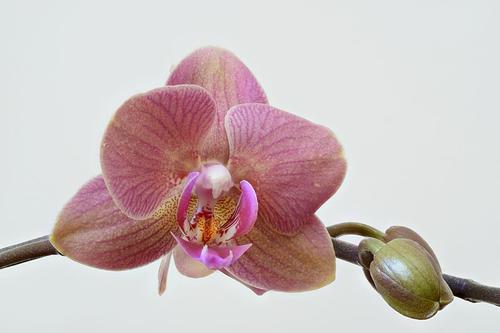 Orchid BelizePhoto: Nicolas Perrault II in the public domain
Orchid BelizePhoto: Nicolas Perrault II in the public domain
For the botanist, Belize is heaven on earth. Four thousand species of trees, plants and flowers in such a small area is unprecedented. For example, there are about 250 types of orchids and 700 types of trees in Belize. Belize is also one of the few countries with thousands of hectares of virtually untouched jungle. Four different types of forest can be distinguished: pine forests, mixed deciduous forests, Cohune palm forests and riparian forests. Pine forests can be found on sandy, dry soil. Mango, cashew, and coconut palm trees are also found here, often near homes and villages. The mixed deciduous forests occur in the transition area between the sandy soil and the clay soil along the rivers. There are many other species, but not as many as in the Cohune palm groves, which can be found on fertile clay soil with an average rainfall per year. Riparian forests depend on a lot of rainfall and flooding rivers. Here are also about 55 types of trees and hundreds of types of climbing plants, epiphytes, and shrubs.
Campêche wood, mahogany, cedar and spruce wood is almost impossible to find along the rivers due to logging. Striking appearances are also mangrove forest, bamboo, ferns, swamp cypresses and many types of flowers. Orchids and flying ferns are found on the highest branches of the trees. In the south you will find the classic rainforest with mahogany trees, campêche trees, sapote and ceiba.
Some special types.
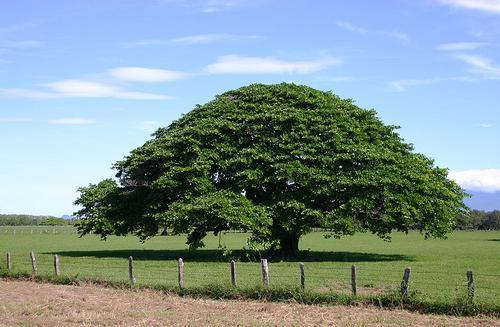
The "bull horn" acacia or cock's spur is named after the large thorns along the trunk and branches. This tree has made a curious alliance with an aggressive ant species. The ants use the tree for food and shelter; in return, birds, insects and even people are attacked who move in or near the tree.
The ceiba with its imposing gray trunk is one of the jungle's largest trees. They normally grow to about 30 meters high, but there are also specimens of more than 60 meters. The "tree of life" is also called cotton or kapok tree.
Guanacaste is a member of the mimosa family. For the Maya, the "pich" was a sacred tree. The tree can reach a height of 40 meters and the trunk can reach a diameter of six meters.
The bark of the gumbo limbo tree has been used by the Mayans for centuries to treat rashes. Young trees are used as posts for fences. What is special is that leaves are starting to grow again on those posts.
The carob tree secretes an aromatic resin. The Maya used this for centuries to make incense.
Palms come in a wide variety. King palm, queen palms, roof palms, and coconut palms. The leaves of the roof palms are used to cover the roofs of houses. The coconut palm produces oil, food, drink and protects from the sun.
Pine forests are not as productive and diverse as the deciduous jungles, but lumber and sap from the trees have been important products since the early 20th century. The Caribbean and the ocarpo are the most common pine species in Belize.
The poison tree (Maya: chechem) is so named because of the highly poisonous sap that the tree secretes. Skin contact causes blisters, itching and swelling.
The family tree is known for its yellow luminous flowers. The name comes from the curassow or quam, a large bird that likes the seeds.
The strangler fig tree entwines other trees that are slowly dying. The fig tree eventually remains and has a hollow trunk.
Central America is, of course, known for its oranges, limes and grapefruit. Avocados are everywhere and the papaya is almost a weed. The sapote or mammee used to provide juice that was used for chewing gum. The guaya is a slender tree, mainly found along the coast, and the fruits contain soft, sweet pulp.
The flamboyant is everywhere and in bloom is beautiful to see with orange-red flowers.
Of the approximately 250 species of orchids in Belize, 20% grow on the ground and 80% live on trees. The black orchid is Belize's national flower. It is strictly forbidden to pick orchids.
Among the many types of flowers we mention: croton, pothos, philodendron, white and red ginger, plumeria, hibiscus and bougainvillea.
Animals
Nature lovers will also get their money's worth in Belize when it comes to the animal world. Many animal species hardly or no longer occur in Central America or even the world.
Birds
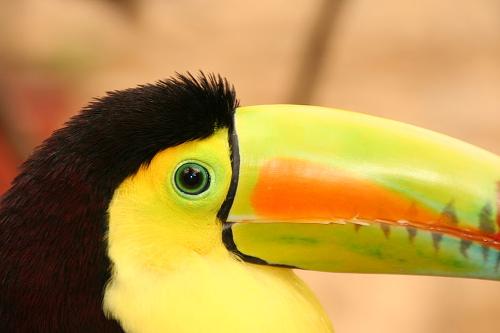 Yellow-billed Toucan BelizePhoto: JurriaanH CC 3.0 Unported no changes made
Yellow-billed Toucan BelizePhoto: JurriaanH CC 3.0 Unported no changes made
There are more bird species in Belize than in almost any other country in Central America, with more than 500 species. Forests, lagoons, and savannas are home to a wide variety of birds. A random list: herons, ibises, ducks, vultures, ospreys, hawks, falcons, rails, pigeons, cuckoos, swifts, kingfishers, woodpeckers, ant birds, flycatchers, sparrows, swallows, jays, wrens, thrushes, nightingales, vireos, tanagers , cardinals, blackbirds, finches, pelicans, cormorants, two kinds of rock spiders, 21 kinds of hummingbirds, 10 kinds of owls and 9 kinds of parrots.
One of the most impressive birds is the Yellow-billed Toucan, Belize's national bird. The large, colored beak is of course the most striking. They are related to woodpeckers and hornbills.
The acorn woodpecker is best known for storing acorns in hollows in trees. The females also lay their eggs in a common nest. The young linger around the parental nest for a number of years before starting a family of their own.
The largest flying bird in the Americas is the Jabiru stork which can grow up to 5 feet tall and have a wingspan of 2 to 3 feet. Their nest can be up to three meters in diameter. Although rare in the Western Hemisphere, Belize has a healthy nesting colony.
The king vulture is one of the most beautifully colored large birds in Central America. A white body with black wing feathers, an orange neck and beak, purple head, white eyes surrounded by red and an orange-red warty projection just above the beak.
The large frigatebird steals food from other birds, but a little later it can nest alongside the same bird.
Belize's "peacock" is the spotted turkey, named for the eye-like rings on its tail. Like its North American counterpart, these are the only wild turkeys in the world.
The piebald tern is not the only seabird without waterproof feathers, but it never lands on ships or driftwood. It catches its prey by skimming just above the water and, as it were, plucking it out of the water.
The most impressive bird of prey is the harpy eagle.
Felines
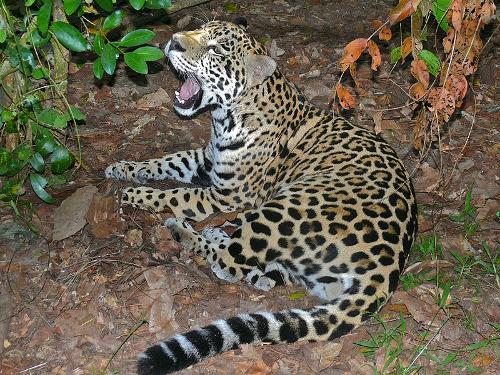 Jaguar BelizePhoto: Bernard DUPONT CC 2.0 Generic no changes made
Jaguar BelizePhoto: Bernard DUPONT CC 2.0 Generic no changes made
The jaguar is the largest feline in the entire American continent and the third largest cat in the world after the lion and tiger. The jaguar hunts, among other things, deer, tapirs, monkeys and birds, but also fish when other prey animals are scarce. Hunting for these animals is now prohibited and the Cocksomb Basin Wildlife Sanctuary is a reserve where the jaguars can (survive) live in peace.
Belize's smallest feline is the margay, rarely seen and living under the protection of the jungle.
The jaguarundi is somewhat larger than the margay and hunts birds and small mammals.
The ocelot hunts both in the trees and on the ground for birds, snakes, monkeys, rabbits and fish.
The cougar or mountain lion hunts deer, rabbits and porcupines both during the day and at night.
Various mammals
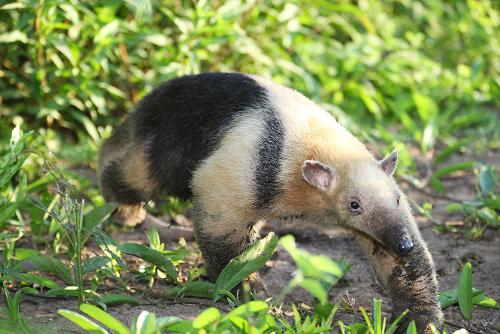 Tamandua BelizePhoto: Nori Almeida CC 2.0 Generic no changes made
Tamandua BelizePhoto: Nori Almeida CC 2.0 Generic no changes made
The black howler monkey lives in the rainforest of Belize up to 300 meters high and often near rivers. The population is about 1500 copies. The roar can be heard up to a mile away. They live in groups of up to 10 individuals and a group consists of one male and the rest of females and young.
The spider monkey is somewhat smaller than the howler monkey and lives in groups of twelve or more individuals. They feed on leaves, fruits and flowers. Due to disease and loss of habitat, they are not as common as the howler monkey.
A relative of the rabbit is the agouti or "Indian rabbit" who lives in the same area as the paca or "gibnut", a fast brown rodent about the size of a rabbit. The agouti lives during the day while the paca is nocturnal.
The anteater or "tamandua" terrorizes termite mounds and ant nests. With its long sticky tongue it gulps down the ants and termites, as it were. The anteater lives both on the ground and in trees.
The coati belongs to the raccoon family and has a long, ringed tail, a mask on its face, and a long snout. It climbs trees and finds insects and other small animals, but also eats fruit.
The Honduran white bat is almost imperceptible in the jungle of Central America. Like most bats, they look for fruit at night. During the day they sleep under the large leaves of the heliconia and thus protect themselves from the hot sun and against enemies.
There are two types of peccary in Belize, the frilled peccary and the white-lipped peccary. This pig-like species lives in desert areas as well as in forests and jungles. They grow up to three feet long and the white-lipped peccary can be a dangerous opponent with its tusks.
Belize's national animal is the South American Baird's tapir native to southern Mexico to southern Brazil. These herbivores live along rivers and their greatest animal enemy is the jaguar.
Belize has a wide variety of lizards, from the small gecko to the chameleon-like black anole, a salamander species. The comb lizard is brown with dark stripes on the side and moves very quickly in case of danger. The common iguana can reach a length of nearly three feet and another species found in Belize can grow up to six feet. The females can lay more than 100 eggs at a time.
Reptiles and Amphibians
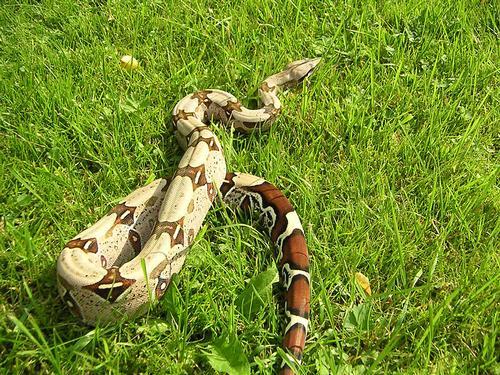
Belize has 51 snake species, nine of which are poisonous. The other species are completely harmless. The common boa constrictor or "wowla" prefers to hunt birds, lizards and small mammals at night both in trees and on the ground. This choke snake never grows longer than two meters and is harmless to humans. Coral snakes are only found in the New World, mostly in Central and South America and there are about 50 species. The coral snakes in Belize grow up to 75 cm in length but can be very poisonous. The poisonous species can be recognized by the red-yellow-black-yellow-red bands across its body. The fer-de-lance or lance point snake is a very aggressive venomous snake and belongs to the same family as the cascabel. It can grow to about 2.5 meters in length and is found everywhere.
The Central American river turtle or "hicatee" is hunted for its meat and its numbers are rapidly diminishing. Food consists of fruits, grasses and other vegetarian foods. Belize has two crocodile species, the American crocodile (up to six meters long) and the Morelet's crocodile (up to 2.5 meters long). Known in Africa as man-eaters, the species in Belize are quite harmless. Both species are protected by international laws.
The green red-eyed tree frog is special. The "marine" toad is the largest species in the entire American continent.
Spiders and insects
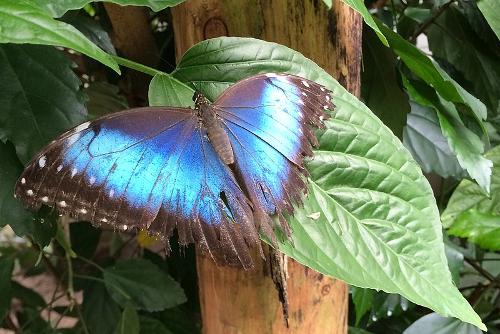 Blue Morpho BelizePhoto: HenkvD CC 4.0 International no changes made
Blue Morpho BelizePhoto: HenkvD CC 4.0 International no changes made
As in any tropical jungle, there are tens of thousands of insects and arachnids in Belize. Some are annoying, mosquitoes and gnats, some are dangerous, scorpions, black widow and tarantulas, others can bite painfully like red ants. Beautiful to see are butterflies and moths.
The horse hornet lays its eggs on mosquitoes, which they transfer back to humans. Not dangerous, but a strange sight when the animal crawls out of the body of its host. Of the 90,000 species of butterflies and moths, many are found in Belize. The most beautiful is the blue morpho and the famous monarch butterfly visits Belize on its wintering trip from Florida to the Central American mountains and Mexican highlands.
The firefly actually has a completely wrong name; it is not a fly and certainly has no fire. It is a beetle whose abdomen starts to glow due to a certain chemical reaction. It has almost no enemies because it doesn't taste so good. The parasol ants use the leaves they transport as "fertilizer" for a particular type of mushroom that they use as food. A nest can be tens of meters in diameter and more than three meters into the depth.
Termites make termite mounds made of wood, mud and body secretions. Wood is the primary food.
Scorpions can grow to about 12 cm in length and have decent claws. The tail is dangerous because it can even fatally injure people.
The tarantula is a large spider that can bite viciously but is not deadly. The spider can reach six inches in diameter and looks dangerous. What is special is that they can go without food and water for a very long time.
Fish and marine mammals
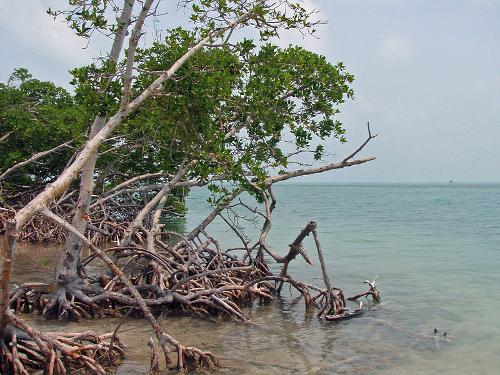 Mangrove BelizePhoto: Anatmavada CC 3.0 Unported no changes made
Mangrove BelizePhoto: Anatmavada CC 3.0 Unported no changes made
The underwater life off the coast of Belize is not as spectacular as that around the Caribbean islands, but there is still plenty to enjoy.
The swampy areas and bays at the mouths of the rivers where fresh and salt water is mixed are called estuaries. Many shellfish and crustaceans, crabs and shrimps live here. Crocodiles, dolphins and (manatees) can also be seen here regularly. Rays, sharks and tarpons hunt other fish here.
There are four types of mangrove along the coast of Belize. The red and black mangroves are the most famous. White mangrove grows a bit more inland along the rivers. Mangrove is a breeding ground for many animal species. In addition to a wide variety of shellfish, barnacles, crabs, jellyfish, snails and sponges. Various types of bony fish and tarpons swim around here in search of the richly available food. The branches of the mangrove are used by many birds to rest and nest, including blackbirds, herons, kingfishers, pelicans and pink spoonbills.
Off the coast, various types of sea grass are found underwater, which is also home to many marine animals. Tortoise grass has wide leaves and can be found up to a depth of 20 meters. The narrower manata grass can be found up to a depth of twelve meters. Animals that occur here include barnacles, shellfish, crabs, anemones, seahorses, sponges, starfish, grunts, loaches, rays and wrasses. Sea turtles and manatees feast on the plants here.
Some special types
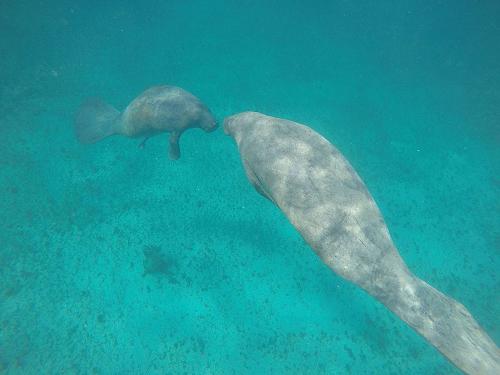 Manatee BelizePhoto: Yiftach T CC 4.0 International no changes made
Manatee BelizePhoto: Yiftach T CC 4.0 International no changes made
The angelfish is a beautiful discus-shaped fish. The colors vary from neon blue and yellow to black with yellow spots. They can be found both inside and outside the barrier reef.
The barracuda is an almost two meter long predatory fish, which is however harmless to humans. Divers can even get close to him.
The blue-striped grouse swims around in schools and prefers shady places. They eat shellfish and make a grunting sound with their molars, which gives them their name.
Sea bass can grow over a meter in length, some species as much as 2.5 meters and weigh hundreds of kilograms. Sea bass species are mainly found around the Hol Chan Marine Reserve and around the atolls.
The green moor eel can grow up to two meters long. It hides in cracks and crevices in the coral during the day and emerges at night to forage for food.
The parrotfish species' beak resembles that of the true parrot and is suitable for eating coral polyps. The color and color patterns of the fish change with age.
Rays "fly" as it were through the sea water. Stingrays, sea devils and devil rays are found in the waters of Belize. The first two types have poisonous spines. They look for their food at the bottom of the sea.
The manatee or sea cow is a large sized marine mammal. They can grow up to four feet long and weigh more than 500 pounds. Belize has one of the largest populations in the world and it is believed that there are only about 2000 specimens left worldwide.
Three species of sea turtle are found in the waters of Belize: the green sea turtle, the hawksbill turtle and the fathead sea turtle. The hawksbill turtle is fully protected, the other species are still on the menus of restaurants.
Sources
Belize
APA
Bradbury, A. / Belize
Bradt
Eltringham, P. / The rough guide to Belize
Rough Guides
Mallan, C. / Belize handbook
Moon Publications
CIA - World Factbook
BBC - Country Profiles
Copyright: Team The World of Info